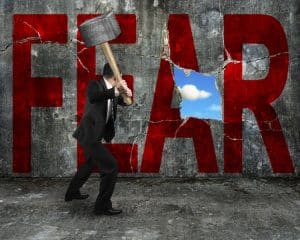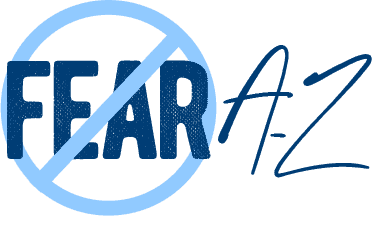Share This Article
What Is Acrophobia?
What is the fear of heights called? Acrophobia is the official term for a fear of heights. The phobia takes its name from the Greek word “acron,” meaning “peak” or “summit.” Acrophobia is a natural environment phobia, with sufferers often avoiding situations in which they may be forced to encounter high places or things associated with them. This can cause severe distress and disruptions in one’s life, such as an inability to ride an escalator or climb up stairs necessary to reach your place of work.

Naturally Occurring or Caused?
The question of “Nature vs. Nurture” is a cornerstone of psychological, philosophical, and sociological thought, including whether phobias are inborn or caused because of traumatic events in our lives.
Evolutionary psychologists posit that conditions such as acrophobia may have arisen as a survival mechanism, warning us away from areas where a fear of falling would have been imminent. Those with this survival instinct would have been more likely to reproduce.
It is important to note that humans are not the only species to suffer from a fear of or reluctance toward heights. In 1960, Eleanor J. Gibson and Richard Walk conducted a series of experiments they termed “The Visual Cliff,” in which human infants along with babies of other species refused to cross a glass panel which appeared to feature a steep drop-off. The encouraging presence of the subjects’ mothers were not able to convince the infants the area was safe. Experiments such as these point to a fear of heights as being an inborn survival instinct shared by different species.
Behavioral psychologists, on the other hand, tend to ascribe phobias to our behaviors, actions and responses to stimuli. Under this model, acrophobia can stem from negative experiences with heights, such as falling off a tree or down the stairs and injuring oneself. In time, this trauma leads to a broader fear of heights. Sometimes, these incidents are so deeply buried in our past that we may not even consciously recognize them as the root cause of our phobias.

Behaviorists also suggest that these fears may be learned vicariously through others. For example, if you see a film where characters fall from incredibly severe heights, or hear intense stories of people falling in real life, you may come to develop a fear of falling, heights, or both.
Both the evolutionary and behaviorist models contribute significantly to the conversation, and the answer to what causes acrophobia is likely a combination of the two.
Causes and Triggers
The presence of heights is obviously the most common trigger for acrophobia. When their fear of heights is triggered, patients’ sympathetic nervous system and fight or flight response is activated. This response is typically triggered by an imminent threat, such as someone attacking you. The fact that acrophobia triggers it, thus, points to how severely a patient’s mind can react when faced with heights. In severe cases, this response can be triggered even by simply thinking about heights.
Acrophobia Symptoms
There are many different potential forms of acrophobia, and it can manifest in a variety of ways. Some of the most common symptoms include:
- Dropping to all fours, kneeling, crawling, or otherwise remaining prone and rooted to the ground while on high ground
- Being paralyzed with fear and unwilling to move
- Panic attacks
- Crying out or yelling
- Sudden headaches, dizziness, lightheadedness, and nausea
- Feeling disoriented or fearing that you will lose your balance
- Sweating, heart palpitations, chest pain or tightness, and rapid heartbeat
Many of these conditions can be exacerbated even further when looking down at the area below from a high place. In some cases, simply seeing or thinking about heights or having to go to high places can be enough to trigger symptoms or a full-blown panic attack.
Vertigo, Acrophobia, and Misconceptions
A fear of heights is a common onscreen phobia for characters to have, especially compared to other phobias, in part because it has a ready-made visual shorthand. Hitchcock’s classic thriller Vertigo is the most well-known example. In the film, the camera quickly zooms in and out to simulate the disorientation and dizziness of the main character, who suffers from both acrophobia and vertigo.
However, while Vertigo is iconic and Hitchcock’s visual style is etched into our collective consciousness, it’s not exactly true to life. The film’s famous zoom-in-zoom-out camera trick visually conflates vertigo and acrophobia, with the technique being used to signify a fear of heights in other media. However, while vertigo and dizziness can be a symptom of acrophobia, it is not a necessary condition for it, nor are the two things the same. Acrophobia can take on many forms and manifest in many ways, whereas vertigo refers specifically to dizziness.
Other People with The Excessive Fear of Heights:
Related Conditions
Vertigo is not the only condition that can be linked to acrophobia. Other phobias which are distinct from but occasionally linked to or triggered by acrophobia include:
- Illyngophobia: Where vertigo can produce dizziness, this condition refers to the fear of developing vertigo, thus, inadvertently giving oneself similar symptoms. If the condition persists, doctors may request blood work, CT scans, MRIs, and other tests to rule out the possibility of underlying neurological conditions.
- Bathmophobia: This refers to a specific fear of slopes and stairs which, in the case of high ones, can be linked to acrophobia. While many sufferers of bathmophobia also suffer from acrophobia, most people with acrophobia do not suffer from bathmophobia.
- Climacophobia: An even more specific condition, and one often linked to bathmophobia, this refers to the specific fear of climbing stairs or slopes.
- Aerophobia: As the “aero” indicates, this refers specifically to the fear of flying. While it can occur along with acrophobia, aerophobia is its own distinct condition with its own set of phobic triggers, ranging from being in the air to the mere sight of an airport or airplane.
Acrophobia Statistics
It is important to distinguish between a mere discomfort with heights and active acrophobia. By some estimates, as many as one in three people may have some discomfort when faced with heights. However, acrophobia specifically refers to those with extreme and irrational fears of heights that are likewise persistent.
As many as 5 percent of people can suffer from some form of acrophobia. According to a 2016 study published by the Journal of Neurology, women were roughly twice as likely to exhibit visual height intolerance, including acrophobia, than men. However, they were also twice as likely to seek help for their symptoms and reported better results following treatment.
Potential Treatment
In terms of how to overcome a fear of heights, there are many potential treatments that can be effective in helping you conquer your phobia, including:
- Cognitive Behavioral Therapy (CBT): This form of therapy exposes the patient to the phobic situation in a controlled fashion. In the case of acrophobia, this can include incremental exposure to increasingly high areas with significant support from staff. Every patient is different, and CBT is typically employed at the patient’s pace.
- Virtual Reality: With VR technology becoming more refined, it is now being used as a more risk-free treatment for acrophobia patients, allowing them to “experience” heights without actually having to go to high places.
- Medication: Beta blockers and sedatives are both sometimes used to relieve the anxiety that comes with a panic attack spurred by conditions such as acrophobia. Another drug, D-cycloserine, has been used in clinical trials for years with some positive indications, though more research is needed.
- Personal Action Steps: Steps patients can take on their own include relaxation techniques, studying the condition, and joining support groups.
SOURCES:
https://www.psycom.net/acrophobia-fear-of-heights/
https://www.healthline.com/health/acrophobia-or-fear-of-heights-symptoms-causes-and-treatment#treatment
https://www.verywellmind.com/acrophobia-fear-of-heights-2671677
http://theconversation.com/health-check-why-are-some-people-afraid-of-heights-82893
Stories Submitted by Our Readers
Fear of Heights
I’m not sure what caused my fear of heights but when I was little, I was upstairs and started down the stairs carrying my blanket. I caught my foot in my blanket near the top of the stairs and fell all the way down. I only had bumps and bruises, but my parents took me to the emergency room.
I get dizzy, find it hard to breathe, and begin sweating just by seeing photos or movies that show the view toward the ground from a building, the sky, or even down into a basement. Any type of height scares me. I cannot use a step ladder that only has two steps without freaking out.
Judy B.
Acrophobia …. heights
I finally found a place where I can read, learn, and participate in discussing my fear which is heights. I have joined other communities, but most are run by professionals that have no idea what it feels like to have this fear. Those that live with acrophobia every day can at least give me ideas of what they have tried that worked some as well as things that did not work at all.
I have had this fear since I was a child and I had a tough time enjoying hiking with family and friends as many times there would be a huge drop off or a valley to see which scared me to death.
The only trick that has helped me was to rub something on my sunglasses to blur the view. I can hike in high places as long as my vision is blurred so this is the best solution for me at least for hiking. At least I don’t freeze in fear. Of course, this only works when I’m hiking. Of course I wouldn’t try this driving! But it works for me when hiking. I think it has something to do with tricking the mind or at least between what the eye sees and the brain interprets.
Fred E Allen








